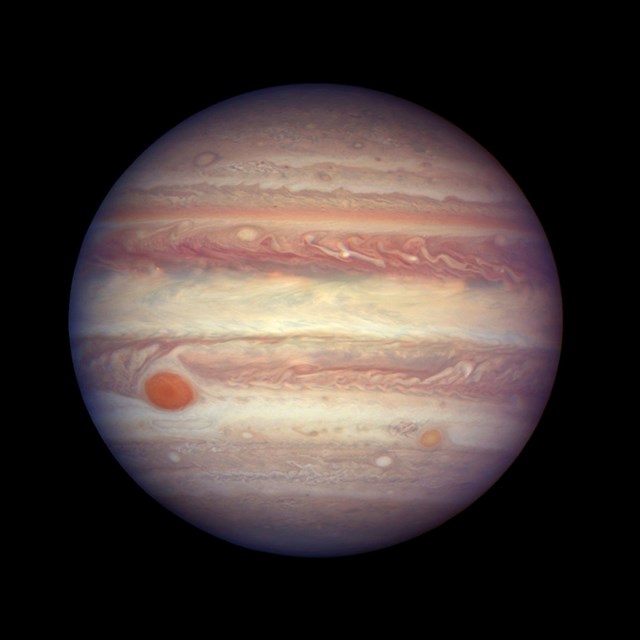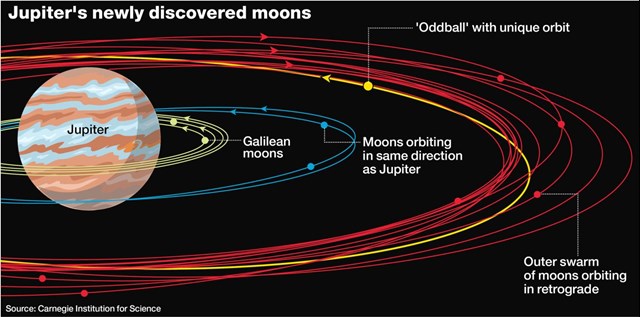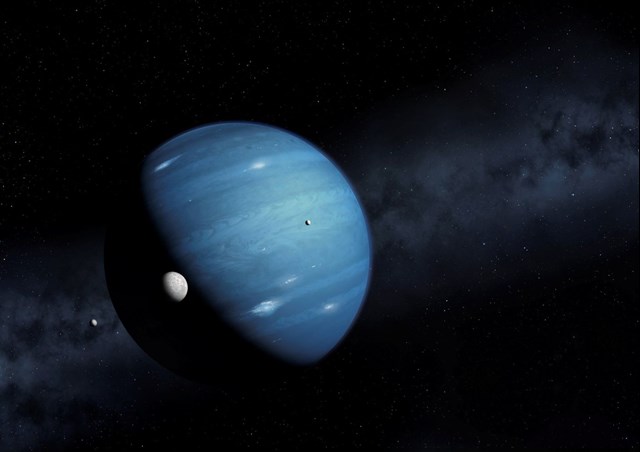
An image of planet Jupiter made available by NASA, April 3, 2017 /AP
Ten moons have been discovered orbiting Jupiter – 9 “normal” outer ones and an “oddball” – scientists from the Carnegie Institution for Science in Washington reported on Tuesday.
Including the previously unknown moons, Jupiter now has 79 known moons orbiting the giant planet, more than any other planet in our Solar System. Saturn has the second highest number of known moons: 61.
The team of scientists, led by Scott Sheppard identified the moons in March 2017 accidentally, while they were searching for very distant small objects on the fringes of the Solar System – including a possibly massive planet well beyond Pluto.
“Jupiter just happened to be in the sky near the search fields where we were looking for extremely distant Solar System objects, so we were serendipitously able to look for new moons around Jupiter while at the same time looking for planets at the fringes of our Solar System,” said Sheppard in a statement released by Carnegie.

The confirmation of 10 of the moons was announced Tuesday; two were confirmed in June 2017. The scientists say the moons had not been seen before because they are tiny - the biggest ones only about two miles across.
“It takes several observations to confirm an object actually orbits around Jupiter,” said Gareth Williams of the International Astronomical Union’s Minor Planet Center. “So, the whole process took a year.” Telescopes in Chile, Hawaii and Arizona were used for the discovery and confirmation.
Sheppard told Haaretz the astronomers were studying the sky near Jupiter and because Jupiter’s orbital velocity is known, anything that moves near it at a similar speed and was not previously known became a candidate for being a new moon. They reexamined the candidates a month later, and then a year later, to make certain that they really were orbiting Jupiter, said Sheppard.
The region near Jupiter that could contain moons is much larger than the area telescopes can see and it takes a long time to survey this region, so it is reasonable to assume more moons with diameters of one to five kilometers are out there waiting to be discovered, said Sheppard.
A video showing how the moons that were discovered around Jupiter turned - דלג
Seven of the new moons are part of a distant outer swarm of moons that orbit it in the retrograde, or opposite direction of Jupiter’s rotation, said Carnegie. These distant retrograde moons are grouped into at least three distinct orbital groupings and are thought to be the remnants of three once-larger parent bodies that broke apart during collisions with asteroids, comets, or other moons. The newly discovered retrograde moons take about two years to orbit Jupiter.
Two other moons are part of a closer, inner group of moons that orbit in the same direction as the huge planet’s rotation. These inner moons all have similar orbital distances and angles of inclinations around Jupiter and are also thought to be fragments of a larger moon that broke apart. These two newly discovered moons take a little less than a year to orbit Jupiter.
“Our other discovery is a real oddball and has an orbit like no other known Jovian moon,” said Sheppard. “It’s also likely Jupiter’s smallest known moon, being less than one kilometer in diameter”.
This “weird” moon moves in the same direction as Jupiter but is father out than the others and takes about a year and a half to orbit planet. This unique orbit brings the new moon far enough that a head-on collision is much more likely to occur between the “oddball” and the retrograde moons, which are moving in opposite directions.
“This is an unstable situation,” said Sheppard. “Head-on collisions would quickly break apart and grind the objects down to dust.”

Planet Nine is a hypothesized massive planet, first proposed in 2014, that is speculated to orbit far out in the solar system, October 2016 MARK GARLICK / Science Photo Lib
It is possible that such collisions are what formed the moons we see today and the oddball moon is the last remnant of a larger moon that collided a number of times with these other moons and led to the creation of today’s retrograde moons. These moons may be the only remnants of the original materials the planets were formed from and understanding them could help understand how the planets were created, added Sheppard.
The name Valetudo has been proposed for this larger moon, after the Roman god Jupiter’s great-granddaughter, the goddess of health and hygiene.
Prof. Oded Aharonson, head of the center for planetary science at the Weizmann Institute of Science in Rehovot, said the importance of the discovery lies not in the exact number of moons found, but in the new light shed on two issues at the heart of the contemporary study of the Solar System. The first is the influence of the collisions between objects within the planetary gravitational field on the formation of the Solar System as we know it today.
The second insight from the research on the new moons of Jupiter, and especially the oddball moon, is that our Solar System is dynamic – and still is today, says Aharonson. The Solar System did not freeze in place 4.5 billion years ago, things are still changing.
Moons are still being born and colliding. In theory, it is possible to calculate when the next collision will occur, if it will happen soon, he says. But the more interesting calculation, in Aharonson’s opinion, is compare Jupiter’s system to that of other similar planetary systems and calculate the average lifespan of such moons – and get a better understanding of the history of Jupiter and its moons.
In 2014, the same team of scientists found the object with the most-distant known orbit in the Solar System and was the first to realize that an unknown massive planet at the fringes of our Solar System, far beyond Pluto, could explain the similarity of orbits of several small extremely distant objects. This putative planet is often popularly called Planet X or Planet Nine.
